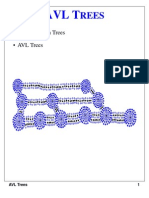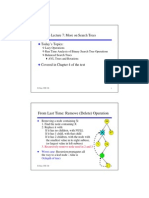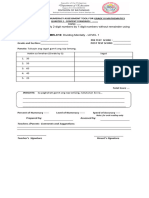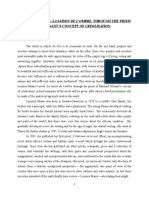Course Outline
Introduction and Algorithm Analysis (Ch. 2)
Hash Tables: dictionary data structure (Ch. 5)
Heaps: priority queue data structures (Ch. 6)
Balanced Search Trees: general search structures (Ch. 4.1-4.5)
Union-Find data structure (Ch. 8.1–8.5)
Graphs: Representations and basic algorithms
Topological Sort (Ch. 9.1-9.2)
Minimum spanning trees (Ch. 9.5)
Shortest-path algorithms (Ch. 9.3.2)
B-Trees: External-Memory data structures (Ch. 4.7)
kD-Trees: Multi-Dimensional data structures (Ch. 12.6)
Misc.: Streaming data, randomization
0
�Search Trees
Searching over an ordered universe of key values.
Maintaining hierarchical information
Repeated linear search in link list too slow for large data
Hashing useful only for “find key” operations.
Heaps useful only for “find Min” or “Find Max”.
But suppose we needed:
Lookup-by-prefix:
type in first few letters of a name and output all names in the database beginning
with those letters.
Find-in-range[key1, key2]: output all keys between key1 and key2
NearLookup(x): returns the closest key to x when x not in database.
Find the kth smallest key.
Rank(x): how many keys are smaller than x.
1
�Search Trees
n With appropriate balanced binary search trees, we can do most of
these operations in worst-case O(log n) time.
searches, inserts, deletes, find successor, find predecessor etc.
n A recursive definition of the tree:
either empty, or
a root node r with 0 or subtrees whose roots are children of r
No other structure: arbitrary distribution of keys and depths
root
T2 T3 T4 ...
T1 T10
2
�Search Trees
Some definitions:
Path: a sequence of edges or nodes
Path Length: number of edges
Depth of a node: number of edges from the root
Parent-Child relationship
Ancestor-Descendant
B C D E F G
H I J K L M N
P Q
3
�An example: directory structure
File directories have a natural tree (hierarchical) structure
Directory traversal and search best visualized by search trees
Tree Traversals:
List all sub-directories: Pre-Order Traversal
Print a node, then recursively traverse subtrees
Compute directory sizes: Post-Order traversal
Compute sizes of all subtrees, then add to get the size of the directory
/usr*
mark* alex* bill*
book* course* junk junk work* course*
ch1.r ch2.r ch3.r cop3530* cop3212*
fall* spr* sum* fall* fall*
syl.r syl.r syl.r grades prog1.r prog2.r prog2.r prog1.r grades
4
�Binary Search Trees (BST)
Each node has at most 2 children (left, right)
Most commonly used form of search tree
Some examples: Heaps, expression trees, branch-bound
BST implements a search ADT
Input: a set of keys
Any set with an ordering, but assume numeric keys for simplicity
For simplicity, also assume all keys are distinct (no duplicates)
A BST is a tree with the following “ordering” property
For any node X:
All keys in the left subtrees < key(X)
All keys in the right subtree > key(X)
5
�Binary Search Trees (BST)
A Binary Search Tree is a tree with the following “ordering” property
For any node X:
All keys in the left subtrees < key(X)
All keys in the right subtree > key(X)
Which of the following are valid BSTs?
6 6
2 8 2 8
1 4 1 4
3 3 7
6
�Find (lookup) Operation in BST
if (t = null) return null
elseif (x < t.key) return find(x, t.left)
elseif (x > t.key) return find(x, t.right)
else return t; // match
6 6
2 8 2 8
1 4 1 4
3 3 7
7
�FindMin or FindMax in BST
FindMax
if (t != null)
while (t.right != null)
t = t.right
return t;
6 6
2 8 2 8
1 4 1 4
3 3 7
8
�Insert Operation in BST
n Do find(X). If X found, nothing to do.
n Otherwise, insert X at the last spot on the path.
if (t = null)
t = new node x; // insert x here //
elseif (x < t.key) Insert(x, t.left)
elseif (x > t.key) Insert(x, t.right)
else;
6 6
2 8 2 8
1 4 1 4
3 3 7
9
�Delete Operation in BST
n Delete is typically the most complex operation.
a. if the node X is a leaf, easily removed.
b. if node X has only one child, then just bypass it (make the
child directly linked to X). Example. Delete 4
6 6
2 8 2 8
1 4 1 4
3 3
10
�Delete Operation in BST
c. if node X has two children,
replace with the smallest node in the right subtree of X;
recursively delete that node.
the second deletion turns out to be easy;
because the second node can't have two children.
11
�Example of Delete
Delete 2.
Swap it with Min in Right Subtree (3). Then Delete (3).
6 6
2 8 3 8
1 5 1 5
3 3
4 4
12
�Analysis of BST
In the worst-case, BST on n nodes can have height n-1.
Each insert/delete takes O(height) time, same as linked list.
For better worst-case, tree needs to be kept balanced
Namely, height O(log n) with n keys
Given a set of keys, easy to build a perfect BST initially:
use the median division rule.
The problem begins when we start doing insert, delete ops.
Suppose we start from an empty tree and do a series of
insertions, what does the tree look like.
Of course, the worst-case is a path: linear depth
What about if insert and deletes were random?
13
�Analysis of BST
Analysis shows that if insertions are done randomly (keys
drawn from [1,n]), then average depth is log n.
The sum of the depths of all the nodes is O(n log n).
Let D(n) be the internal path length.
If i nodes in the left, and (n – i - 1) on the right, then
D(n) = D(i) + D(n - i - 1) + (n - 1).
Under random insertions, the value of i varies uniformly
between 0 and n-1, and so
D(n) = 2/n ( D(j)) + (n-1)
A famous recurrence, which solves to D(n) = O(n log n).
14
�15
randomly generated
Alternate insertions
and deletions
�AVL trees
AvL Trees are a form of balanced binary search trees
Named after the initials of their inventors
Adelson-Velskii and Landis
One of the first to achieve provable guarantee of
O(log n) worst-case for any sequence of insert and
delete operations.
A binary tree cannot do better!
16
�AVL trees
How do we ensure that an AVL tree on n nodes has height
O(log n) even if an adversary inserts and deletes key to get
tree out of balance?
Simply requiring that the left and right children of the root
node have the same height is not enough:
They can each have singly branching paths of length n/2
17
�Balance Conditions for AVL trees
Demanding that each node should have equal height for
both children too restrictive---doesn’t work unless n = 2k – 1
AVL Trees aim for the next best thing:
For any node, the heights of its two children can differ by at most 1
Define height of empty subtree as -1
Height of a tree = 1 + max{height-left, height-right}
Which of the following are valid AVL trees?
5 7
2 8 2 8
1 4 7 1 4
3 3 5
18
�Height of AvL Trees
Theorem: An AVL tree on n nodes has height O(log n)
What is the minimum number of nodes in a height h AvL tree.
What is the most lop-sided tree?
19
�Bound for the Height of AvL Trees
n Recursive construction
n Let S(h) = min number of nodes in AVL tree of height h
S(h) = S(h-1) + S(h-2) + 1
Like Fibonacci numbers. Solves to h = 1.44 log (n+2).
20
�Keeping AVL Trees Balanced
n Theorem: An AVL tree on n nodes has height O(log n)
n Building an initially balanced tree on n keys is easy.
n The problem is insertions/deletions cause unbalance.
n AVL trees perform simple restructuring operations on the
tree to regain balance.
n These operations, called rotations, change a couple of
pointers.
n We will show that an insert, delete, or search operations
touches O(1) nodes per level of the tree, giving O(log n)
bound.
21
�Tree Rotations
right rotation
b
d
d
b
A
E
C E
A C
left rotation
22
�AVL Tree Rebalancing
We only discuss inserts; deletes similar though a bit more
messy.
How can an insert violate AVL condition?
Before the insert, at some node x the height difference
between children was 1, but becomes 2 after the insert.
We will fix this violation from bottom (leaf) up.
23
�AVL Tree Rebalancing
n Suppose A is the first node from bottom that needs rebalancing.
n Then, A must have two subtrees whose heights differ by 2.
n This imbalance must have been caused by one of two cases:
(1) The new insertion occurred into
the left subtree of the left child of A; or
the right subtree of the right child of A.
(2) The new insertion occurred into
the right subtree of the left child of A; or
the left subtree of the right child of A.
(1) and (2) are different: former is an outside (left-left, or right-right)
violation, while the latter is an inside (left-right) or (right-left) violation.
We fix (1) with a SINGLE ROTATION; and (2) with a DOUBLE ROTATION.
24
�Single Rotation
n Insert 6. Where is the AVL condition violated?
n Case (1): insertion into the left subtree of the left child of A
n Fixed by rotation at 7.
5 5
2 8 2 7
1 4 7 1 4 6 8
3 6 3
25
�Single Rotation: Generic Form
k2 k1
k1 k2
Z
X
Y Y Z
X
k1 k2
k2 k1
X
Y X Y Z
Z
26
�Single Rotation: Example
Perform inserts in the following order:
3, 2, 1, 4, 5, 6, 7.
27
�Failure of the Single Rotation
Single rotation can fail in case (2):
Insert into right subtree of left child or vice versa
k2 k1
k1 k2
Z X
X Z
Y Y
28
�When Single Rotation Fails: Double Rotation
Need to look one level deeper.
Called Double Rotation: generic form
One of B or C is at level D+2.
k3 k2
k1 k1 k3
k2 D
B C
A A D
B C
29
�Double Rotation: Example
To the example of previous AVL tree (keys 1-7),
insert 16, 15, 14, …., 10, followed by insert 8, 9
30
�Removing an element from an AVL tree
Similar process:
locate & delete the element
adjust tree height
perform up to O(log n) necessary rotations
Example
Complexity of operations:
O(h) = O(log n)
n : number of nodes, h : tree height
31
�Deletion Example
15 delete 10 15
10 30 5 30
5 12 17 35 12 17 35
14 20 31 40 14 20 31 40
50 50
30 15
15 35 12 30
12 17 31 40 5 14 17 35
5 14 20 50 20 31 40
50
32
�AVL Tree Complexity Bounds
An AVL Tree can perform the following operations
in worst-case time O(log n) each:
Insert
Delete
Find
Find Min, Find Max
Find Successor, Find Predecessor
It can report all keys in range [Low, High] in time
O(log n + OutputSize)
33
�More illustrations… Single Rotation (left-left)
1
2
2
1
Z
X Y Z
Y
Y cannot be at X’s level
Y cannot be at Z’s level either
34
�Single Rotation (right-right)
1 2
2 1
X
Z
Y X Y
Y cannot be at Z’s level
Y cannot be at X’s level either
35
�Double Rotation (left-right): Single Won’t Work
Single rotation does not work because it does not make
Y any shorter
1
2
2
1
Z X
Z
X
Y Y
36
�Double Rotation (left-right): First Step
First rotation between 2 and 1
3 3
1 2
D
D 1
2
C
A
B
B C
A
37
�Double Rotation (left-right): Second Step
Second rotation between 2 and 3
3 2
3
2 1
D
1
C B C D
A
B
A
38
�Double Rotation (left-right): Summary
2
3
3
1 1
D
2
B C D
A A
B C
39
�Double Rotation (right-left): First Step
First Rotation between 2 and 3
1 1
3 2
A A
2 3
B
D
C
B C D
40
�Double Rotation (right-left): Second Step
Second Rotation between 1 and 2
2
1
2 3
1
A
3
B B C D
A
C
D
41
�Double Rotation (right-left): Summary
2
1
3 3
1
A
2
B C D
D A
B C
42
�Insertion into an AVL tree AvlTree
AvlNode
Tree height element
right
left
Search height
Insertion: AvlTree::insert(x, t)
search to find if (t = NULL)
then t = new AvlNode(x, …);
insertion point else if (x < t→element)
then
adjust the tree insert (x, t→left);
height if (height(t→left) – height(t→right) = 2)
then if (x < t→left→element )
rotation if necessary then rotateWithLeftChild (t);
else doubleWithLeftChild (t);
else if (t→element < x )
then
insert (x, t→right);
if (height(t→right) – height(t→left) = 2)
then if (t→right→element < x)
then rotateWithRightChild (t);
else doubleWithRightChild (t);
t→height =
max{height(t→left), height(t→right)}+1;
43






















































































